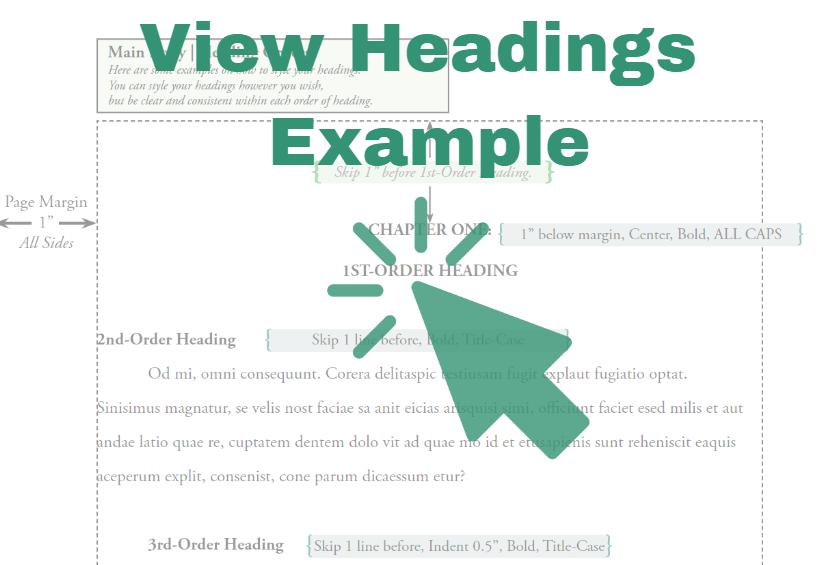General
Headings
 |
Example: Headings
Headings in Theses and Dissertations
All theses and dissertations must include multiple levels (or orders) of headings to organize chapters and sections. Headings guide the reader through the manuscript and indicate increasing specificity as levels progress. While most style guides allow up to six heading levels, most theses and dissertations use no more than four.
The style and position of each order of heading must be consistent across chapters to avoid confusion.
Formatting Headings
- Different capitalization schemes are used to distinguish heading levels. Most commonly:
-
ALL CAPS
-
Title Case
-
Sentence case
-
-
In addition to capitalization, headings may be differentiated by formatting features such as bold, italic, underlining, alignment (centered, left-aligned, right-aligned), or or combinations thereof.
- While formatting styles may vary, they must be applied consistently across all chapters.
- Note that a shift from Title Case to Sentence case is not sufficient on its own, because with one word headings there is no discernable difference.
- The font size for all headings and page numbers must match the body text.
- All headings that appear in the manuscript must also be listed verbatim in the Table of Contents (TOC).
1st-Order Headings (Chapter and Major Section Headings)
- First-order headings (e.g., chapter titles) must:
- Begin on a new page.
- Be positioned flush with the top margin of the new page*
- Use the Enter key to space down 1" from the top margin.
- TIP: In Microsoft Word, enable the ruler (View > Ruler). With the formatting marks turned on, use the "Enter" key to space exactly 1 inch from the top margin, and ensure the heading aligns with the 1-inch mark on the left. Set spacing above the heading to single for more precise control, but make sure the heading remains double-spaced.
*Note: Starting Spring 2026, all Level 1 headings must begin on a new page and be flush with the top margin. Until then, level 1 headings may be placed either flush with the top margin or 2 inches from the top, but placement must be consistent throughout the manuscript.
2nd- to 6th-Order Headings (Subheadings)
Subheadings should follow continuously in the text and not begin on a new page, unless they are orphaned at the bottom of a page, in which case they should be moved to the top of the next page.
- Each heading level must have a unique and consistent style. Acceptable distinctions
include:
- Bold
- Italics
- Indentation
- Other style combinations
You may choose your formatting approach, but it must be used consistently throughout the document. We do recommend you defer to the style guide preferred by your discipline or major professor.
Numbering
Numbering headings is optional. Numbering headings is not a requirement for ETD.
If you choose to number your headings:
- Each level must still be visually distinct (differing by at least one formatting element).
- Numbering and formatting must be consistent across all heading levels and throughout the manuscript.